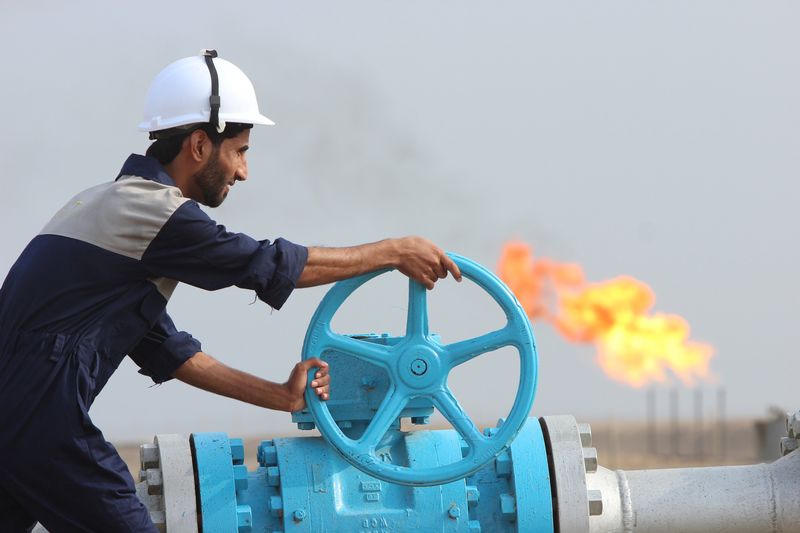Oil jumps 5% on Kurdish exports halt, trimming looming Q1 loss

LCO
+0.39%
Add to/Remove from Watchlist
Add to Watchlist
Add Position
Position added successfully to:
Please name your holdings portfolio
Type:
BUY
SELL
Date:
Amount:
Price
Point Value:
Leverage:
1:1
1:10
1:25
1:50
1:100
1:200
1:400
1:500
1:1000
Commission:
Create New Watchlist
Create
Create a new holdings portfolio
Add
Create
+ Add another position
Close
CL
+0.65%
Add to/Remove from Watchlist
Add to Watchlist
Add Position
Position added successfully to:
Please name your holdings portfolio
Type:
BUY
SELL
Date:
Amount:
Price
Point Value:
Leverage:
1:1
1:10
1:25
1:50
1:100
1:200
1:400
1:500
1:1000
Commission:
Create New Watchlist
Create
Create a new holdings portfolio
Add
Create
+ Add another position
Close
By Barani Krishnan
Investing.com — Crude prices jumped as much as 5% Monday as disruption of half a million barrels a day of Kurdish supply, nuclear war talk by Russia’s Vladmir Putin and assurances about the crisis-hit U.S. banking sector helped boost risk-on appetite in oil.
Crude markets were also being closely watched to determine how successful they’ll be in trimming a big potential loss for the first quarter that’s looming as Friday’s trade — the last for this March — approaches.
New York-traded West Texas Intermediate, or WTI, crude settled up $3.55, or 5.1%, at $72.81 per barrel. Monday’s gains add to the latest rebound in the U.S. crude benchmark, which rose 3.8% last week after the previous week’s 13% drop.
London-traded Brent crude settled up $3.13, or 4.2%, at $78.12. The U.K. crude benchmark finished up 2.8% last week, after the previous week’s 12% tumble.
Even with Monday’s gains, both WTI and Brent stand to lose almost 10% each at the close of the first quarter — unless the two benchmarks are able to make up the deficit in the four remaining days of trade till Friday.
“It’s been a volatile few weeks for crude, caught up in the banking storm as investors are forced to scale back their expectations for the economy which, in turn, has weighed heavily on demand prospects,” Craig Erlam, analyst at online trading platform OANDA, said.
“With sentiment slowly improving and yields inching cautiously higher, so too are oil prices. It may take some time for the dust to settle and prices to fully reflect the new outlook after such a turbulent period which should ensure volatility remains for now.”
About half a percent of global oil supply, or 450,000 barrels per day (bpd), of crude exports from Kurdistan stopped on Saturday after a victory in an arbitration case confirmed Baghdad’s consent was needed to ship the oil from Turkey, Reuters reported, adding that this could also force cuts to oil output in the Kurdistan region.
On the banking front, First Citizens BancShares Inc (NASDAQ:FCNCA) said it will acquire the deposits and loans of failed Silicon Valley Bank, closing one chapter in the crisis of confidence that has ripped through financial markets.
The Federal Reserve’s Vice Chair for Supervision Michael Barr said the central bank will be “fully accountable” for any supervisory or regulatory failures involving Silicon Valley Bank, which was the first to fall among U.S. banks two weeks ago, triggering a domino effect. Barr, who is due to testify before US lawmakers on Tuesday, however, admitted in a pre-testimony speech released Monday that “contagion from SVB’s failure could be far-reaching and cause damage to the broader banking system.”
On the Russian front, President Putin’s plans to station tactical nuclear weapons in Belarus represented the most pronounced nuclear signals yet. It was also a warning to NATO over its military support for Ukraine, which has called for a meeting of the U.N. Security Council in response. NATO slammed Putin for what it called his «dangerous and irresponsible» nuclear rhetoric.
In terms of Russian oil production, Deputy Prime Minister Alexander Novak said Moscow was close to achieving its target of cutting crude output by 500,000 barrels per day (bpd) to about 9.5 million bpd. But Russia’s crude exports are expected to remain steady as it cuts refinery output in April, data from industry sources and Reuters calculations showed on Friday.




